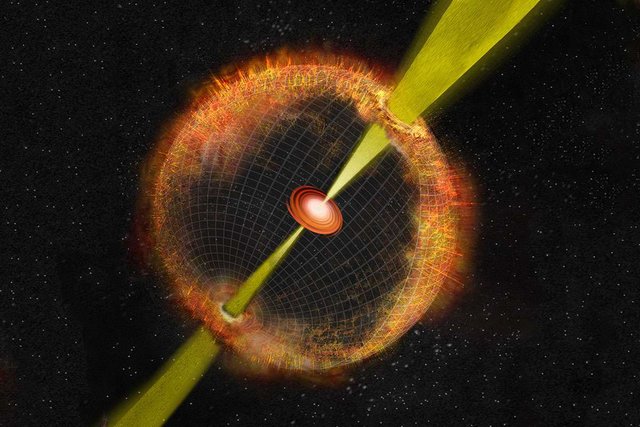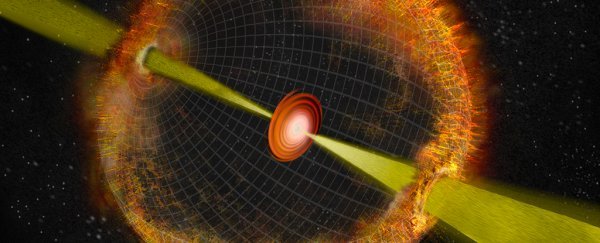Astronomers Are Getting Excited Over Ghostly Traces of a Massive Cosmic Explosion


A comparison of surveys taken of the sky years apart has revealed an empty space where a star 280 million light years away once sat.
Coded FIRST J1419+3940, records of the object hint at what would have been a violent death. Curiously, no trace of its final explosive moments can be found – but this ghostly silence has only made astronomers all the more excited
We compared images from old maps of the sky and found one radio source that was no longer visible today in the Very Large Array Sky Survey (VLASS)," says astronomer Casey Lawfrom the University of California, Berkeley.
"Looking at the radio source in other old data shows that it lived in a relatively nearby galaxy, and back in the 1990s, it was as luminous as the biggest explosions known, gamma-ray bursts."
Gamma ray bursts (GRBs) are the cosmological equivalent to flashes of lightning on the galactic horizon. They're sudden, brilliant, and release of huge amounts of energy in what are effectively the most violent explosions in the Universe.
The mechanisms behind these intense surges of light aren't well understood, but they appear to be caused by the final collapse of massive stars as gravity claims victory over their cooling body, or the merging of neutron stars.
Though technically rare, they're bright enough for us to detect in other galaxies, giving us plenty of opportunities to spot. In fact, we should expect to see around 500 of them per day, on average.
But there is a catch. The sheer amount of energy behind the flash indicates it's most likely in the form of a channelled beam rather than a neatly distributed sphere of bright light.
That means we would only see them when those beams are directed right at us, limiting our observations to a paltry one a day. And that's only if we can find them.
It started with a bang – at least, it must have. Astronomers have spotted a weird radio signal from space that appears to be the shock wave from an enormous explosion, but we never saw the explosion itself.
Casey Law at the University of California Berkeley and his colleagues were comparing two maps of radio wave sources in the sky when they noticed something strange: an object that had been one of the brightest on a map generated in 1993
The discovery of J1419+3940 just might change all that.
"Its peak brightness in the '90s was quite high, so it was a big, big change: about a factor of 50 decrease in brightness," says Law.
"We basically went through every radio survey, every radio dataset we could find, every archive in the world, to piece together the story of what happened to this thing."
The story they settled on suggested it should have resulted in a bright flash of intense gamma radiation immediately before fading from view.
It was in the right neighbourhood – a dwarf galaxy – for the right kind of stars, and brightened just like a supernova. It had more than likely been an object roughly 40 times the mass of our own Sun, ending up as a black hole or a highly magnetised neutron starp,
Based on such estimates, they should have seen a minute-long GRB from that region some time in 1992 or 1993. Unfortunately no sign of that swan song could be seen. Just the vibrant glow of radio waves, like embers of a dying fire.
Those radio waves have since died away. The 2017 VLASS found nothing.
Either they were wrong about GRBs or our multitude of sensitive telescopes simply weren't in its line of fire. If the latter reason was true, this would be the first observation of a GRB event made without detecting any actual gamma rays.
"This is exciting, and not just because it probably is the first 'orphan' GRB to be discovered," says Law.
It's believed that the burst of gamma radiation had slammed into the expanding shell of gas released by the supernova explosion, resulting in a shockwave of radiation we could detect as relatively low energy radio waves.
Finding more of these shockwaves could tell us a lot about these awesome phenomena. For example, we could compare the number of orphan afterglows with the number of bursts to improve our precision on the characteristics of these powerful jets.
Since the VLASS will be making several scans of roughly 80 percent sky over the next seven years, it's more than likely we'll pick up more examples of missed GRBs, providing a more accurate picture of their prevalence and distribution.
"This shows the exciting capabilities of the new generation of wide-field radio surveys," says the director of the Dunlap Institute for Astronomy & Astrophysics at the University of Toronto, Bryan Gaensler.
"There are dramatic and dynamic explosions and flares happening out there, but we can only find them if we can constantly patrol the sky to see what's changing.
Congratulations @kuldeepsinghk! You have completed the following achievement on the Steem blockchain and have been rewarded with new badge(s) :
Click on the badge to view your Board of Honor.
If you no longer want to receive notifications, reply to this comment with the word
STOPDo not miss the last post from @steemitboard:
Congratulations @kuldeepsinghk! You received a personal award!
You can view your badges on your Steem Board and compare to others on the Steem Ranking
Vote for @Steemitboard as a witness to get one more award and increased upvotes!